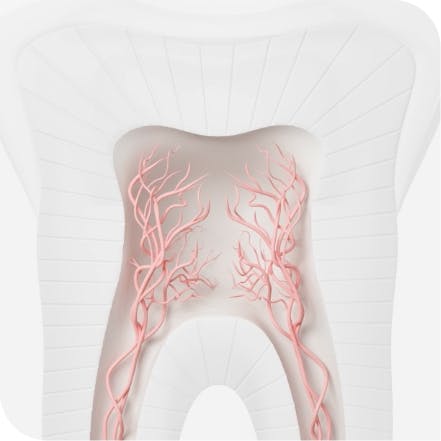Understanding Tooth Sensitivity After a Root Canal
Getting a root canal may not sound like the most fun way to spend your time, but the truth is, this procedure is quite routine and can be effective in eliminating the pain or discomfort that comes from damage or infection on the inside of your tooth.1 What happens, though, if you still have tooth sensitivity after a root canal? Some temporary discomfort is to be expected and there are ways to manage the pain if the root canal tooth is sensitive.2 However if your pain is lasting or severe—or if you have any questions about your root canal—you should contact your dentist. Read on to learn more about root canals and what you can do if a tooth is still sensitive after a root canal.
What is a root canal?
Root canals are a treatment to save a tooth that has been badly damaged or infected. People who need a root canal often have of pain when chewing or biting1 and the tooth may experience lingering sensitivity to cold or hot, among other symptoms like swollen, tender, or darkening gums.1 The procedure involves removing the infected or inflamed tissue within the tooth (known as pulp tissue), cleaning the inside of the tooth, then filling and resealing it.1 During a root canal, patients undergo local anesthesia, much like other dental procedures such as a filling or wisdom teeth removal.1
Sometimes after a root canal, a crown is placed on the tooth to keep it from getting damaged in the future. This crown or filling restoration may or may not happen on the day of the root canal procedure.2
Normal sensitivity after a root canal
Immediately following a root canal procedure, you will likely still be numb in the area. Once that wears off, it’s normal to feel some discomfort as your body heals for the first few days after a root canal. You may feel soreness around the area and the root canal tooth may be sensitive.2 If you have mild to moderate pain, you may consider taking an over-the-counter pain reliever.2
If your pain is extreme or lasts more than a few days, call your dentist or root canal specialist.
Long-term sensitivity after a root canal
Endodontic treatments are reported to have a success rate of 86% to 98%, but it isn’t impossible that a tooth may need further treatment following a procedure.3
If you experience one or multiple of the following symptoms, you will likely need to revisit your dentist or endodontist:2
- Severe pain or pressure
- Visible swelling
- Pain, sensitivity, or other symptoms you experienced prior to treatment
Root canal retreatment
Sometimes a treated tooth will need to be revisited. This can happen for a number of reasons, including:4
- Not all of the infection was cleared from the canal originally
- The crown placement or restoration didn’t occur soon enough after the root canal procedure and bacteria entered the tooth
- The restoration allowed saliva contamination to enter the tooth
- The patient sustains a new cavity and the tooth gets a new infection
- The tooth is broken or fractured
If your tooth is still sensitive after a root canal or you experience other pain or swelling in the area, see your dentist or endodontist to discuss your options. You may need retreatment to save the tooth or you might consider endodontic surgery.4
Manage your root canal tooth sensitivity
If you experience severe or long-lasting tooth sensitivity to hot or cold, or experience other sharp pains around your tooth, talk to your dentist about treatment options. Remember that mild discomfort or tooth sensitivity after a root canal is normal and can be managed with over-the-counter pain relief.
Source Citations:
- What is a Root Canal? American Association of Endodontists. https://www.aae.org/patients/root-canal-treatment/what-is-a-root-canal/. Accessed 7/13/21. Referenced text is indicated in source PDF.
- Post Treatment Care. American Association of Endodontists. https://www.aae.org/patients/your-office-visit/post-treatment-care/. Accessed 7/13/21. Referenced text is indicated in source PDF.
- Failure of endodontic treatment: The usual suspects. European Journal of Dentistry. https://www.ncbi.nlm.nih.gov/pmc/articles/PMC4784145/. Accessed 7/13/21. Referenced text is indicated in source PDF.
- Endodontic Retreatment Explained. American Association of Endodontists. https://www.aae.org/patients/root-canal-treatment/endodontic-treatment-options/endodontic-retreatment/endodontic-retreatment-explained/. Accessed 7/13/21. Referenced text is indicated in source PDF.













